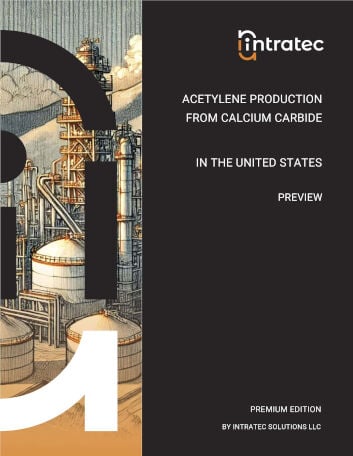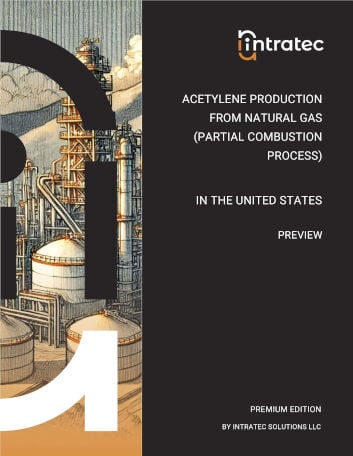Commodity Production Costs Report
Vinyl Chloride Production from Acetylene
Vinyl Chloride Plant Capital & Operating Cost Analysis | United States | Q3 2025
This report presents the economics of Vinyl Chloride production from acetylene and hydrogen chloride. The process examined is a typical acetylene hydrochlorination process. In this process, anhydrous hydrogen chloride is reacted in vapor phase with acetylene over a mercuric chloride catalyst, producing Vinyl Chloride.
The report provides a comprehensive study of Vinyl Chloride production and related Vinyl Chloride production cost, covering three key aspects: a complete description of the Vinyl Chloride production process examined; an in-depth analysis of the related Vinyl Chloride plant capital cost (Capex); and an evaluation of the respective Vinyl Chloride plant operating costs (Opex).
The Vinyl Chloride production process description includes a block flow diagram (BFD), an overview of the industrial site installations, detailing both the process unit and the necessary infrastructure, process consumption figures and comprehensive process flow diagrams (PFD). The Vinyl Chloride plant capital cost analysis breaks down the Capex by plant cost (i.e., ISBL, OSBL and Contingency); owner's cost; working capital; and costs incurred during industrial plant commissioning and start-up. The Vinyl Chloride plant operating costs analysis covers operating expenses, including variable costs like raw materials and utilities, and fixed costs such as maintenance, labor, and depreciation.

The process under analysis comprises three major sections: (1) Reaction; (2) VCM Purification; and (3) Acetylene Recovery.
Reaction. Compressed acetylene is passed through dryers for removal of any residual moisture and then fed to guard beds to remove any contaminants that may damage catalyst activity. Purified acetylene is mixed with anhydrous hydrogen chloride. The gaseous raw materials are fed to a multi-tubular heat exchanger, in which tubes are packed with catalyst and a cooling fluid is fed to the shell to remove the heat generated by the reaction.
VCM Purification. The reaction effluent is twice scrubbed with water and caustic solution to remove any hydrogen chloride. A diluted hydrochloric acid is sent to hydrogen chloride recovery and wastewater is disposed. Gaseous effluent is recompressed, cooled and fed to a three-phase separator. The uncondensed light ends are transferred to the Acetylene Recovery.The organic liquid phase is transferred to a column for further purification. Vinyl Chloride crude product is recovered as the bottom stream. VCM crude product is fed to the final purification column, where purified VCM is recovered in the column overhead and stored.
Acetylene Recovery. Uncondensed light ends from the Dehydration Column are fed to an absorption column, in which acetylene is absorbed in liquid chlorinated hydrocarbons. Acetylene absorbed is recovered in a stripping column. The acetylene removed as overhead stream is recycled to reactor feed.
Report in PDF Format
Download & Explore Anytime
Access in Various Devices
Print & Read Comfortably
Share With Co-workers
Up-to-date Report
Professional report based on Q3 2025 economic data, ensuring timely evaluations.
Multiple Use Cases
Ideal for investment screening, feasibility studies, cost estimates, and research planning.
Proven Methodology
Developed using a consistent methodology honed over a decade, ensuring reliable cost analyses.
Report Editions
Content Highlights
Plant Capital Cost Summary
Summary outlining the capital cost required for building the Vinyl Chloride production plant examined.
Plant Capital Cost Details
Detailing of fixed capital (ISBL, OSBL & Owner’s Cost), working capital and additional capital requirements.
Plant Cost Breakdowns
Breakdown of Vinyl Chloride process unit (ISBL) costs and infrastructure (OSBL) costs; plant cost breakdown per discipline.
Operating Costs Summary
Summary presenting the operating variable costs and the total operating cost of the Vinyl Chloride production plant studied.
Operating Cost Details
Detailing of utilities costs, operating fixed costs and depreciation.
Plant Capacity Assessment
Comparative analysis of capital investment and operating costs for different Vinyl Chloride plant capacities.
Production Process Information
Block Flow Diagram, descriptions of process unit (ISBL) and site infrastructure (OSBL).
Process Consumptions
Raw materials and utilities consumption figures, by-products credits, labor requirements
Process Diagrams
Process flow diagrams (PFD), equipment list and industrial site configuration
Other Vinyl Chloride Production Cost Reports

Vinyl Chloride from Ethylene and Chlorine (Balanced Process)
This study presents the economics of Vinyl Chloride (VCM) production from ethylene and chlorine in the United States. Initially, ethylene is chlorinated to produce ethylene dichloride (EDC). Then, EDC is thermally cracked yielding VCM and HCl. The HCl produced and ethylene are reacted with oxygen, yielding more EDC. This leads to a so called “balanced process”.
Details: 500 kta United States-based plant | Q3 2025 | 107 pages | Issue D | From $1,499 USD

Vinyl Chloride Production from Ethylene and EDC
This report presents the production cost of Vinyl Chloride from ethylene and ethylene dichloride (EDC) in the United States. The process examined combines two process. First, Vinyl Chloride is produced via thermal cracking of EDC, which generates hydrogen chloride (HCl). It is then used as raw material with ethylene in the EDC production via oxychlorination.
Details: 500 kta United States-based plant | Q3 2025 | 107 pages | Issue E | From $1,199 USD

Vinyl Chloride from Ethylene and Chlorine (By-Product: HCl)
This study approaches a detailed cost analysis of Vinyl Chloride (VCM) production from ethylene and chlorine as raw materials. Initially, ethylene is chlorinated to produce ethylene dichloride (EDC). Then, EDC is thermally cracked yielding VCM. The economic analysis presented assumes a plant located in the United States.
Details: 500 kta United States-based plant | Q3 2025 | 107 pages | Issue F | From $1,199 USD
Bundle & Save
Purchase multiple Vinyl Chloride Production Cost reports and enjoy tiered discounts
up to 30% off!
Could Not Find the Report You Need?
Obtain a Bespoke Report
Get a report targeting the process in which you are interested
See Offer Details
Understand Bespoke Reports and how you can easily order them
Check Editions & Pricing
Complete a brief form and see a quotation for your Bespoke Report
Other Related Production Cost Reports

Polyvinyl Chloride Production from VCM (Bulk Polymerization)
This study presents the economics of Polyvinyl Chloride (PVC) production from vinyl chloride monomer (VCM) in the United States. The process examined is a typical bulk polymerization process.
Details: 100 kta United States-based plant | Q3 2025 | 107 pages | Issue B | From $799 USD

Hydrogen Chloride Production from Hydrogen and Chlorine
This study analysis the economics of Anhydrous Hydrogen Chloride (HCl) production from hydrogen and chlorine in the United States. The process examined is a typical synthesis of Hydrogen Chloride via the direct reaction of the elements.
Details: 25 kta United States-based plant | Q3 2025 | 107 pages | Issue A | From $799 USD

Acetylene Production from Calcium Carbide
This study presents the economics of Acetylene production from calcium carbide in the United States via wet process. In the process, calcium carbide reacts with water to form Acetylene. Hydrated lime is generated as by-product.
Details: 200 kta United States-based plant | Q3 2025 | 107 pages | Issue D | From $799 USD

Polyvinyl Chloride Production from VCM (Suspension Polymerization)
This report presents the economics of Polyvinyl Chloride (PVC) production from vinyl chloride monomer (VCM) in the United States, via a typical suspension polymerization process. In this process, VCM droplets dispersed in water are polymerized to PVC.
Details: 400 kta United States-based plant | Q3 2025 | 107 pages | Issue A | From $799 USD

Acetylene Production from Natural Gas (Partial Combustion Process)
This report presents the economics of Acetylene production from natural gas using a partial combustion process similar to that developed by BASF. In this process, methane from natural gas is cracked in high temperatures to acetylene and hydrogen. The economic analysis developed is based on a plant constructed in the United States.
Details: 50 kta United States-based plant | Q3 2025 | 107 pages | Issue A | From $799 USD
+800 Reports Developed, Targeting +250 Commodities
Vast Report Library
858 independent and up-to-date reports examining embryonic and established production processes.
Free Sample Reports
Quickly understand the structure and depth of content of our professional reports.

